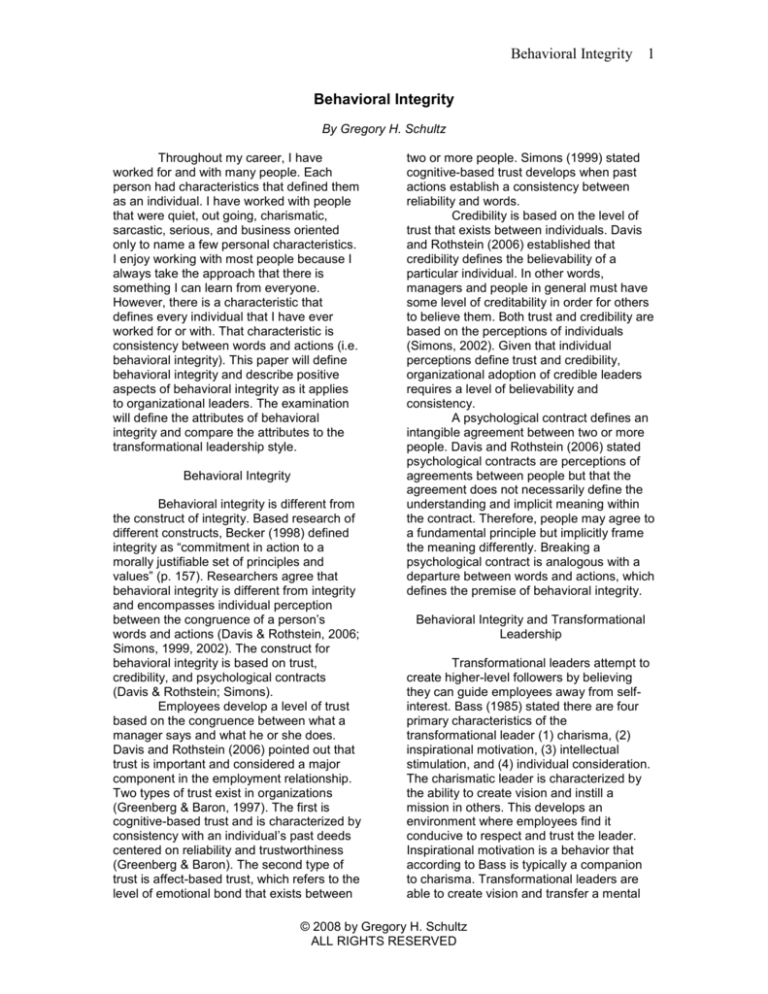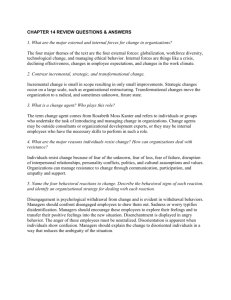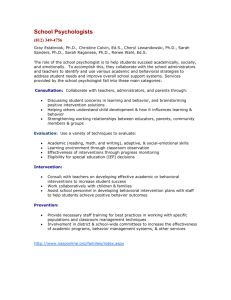
Behavioral Integrity 1
Behavioral Integrity
By Gregory H. Schultz
Throughout my career, I have
worked for and with many people. Each
person had characteristics that defined them
as an individual. I have worked with people
that were quiet, out going, charismatic,
sarcastic, serious, and business oriented
only to name a few personal characteristics.
I enjoy working with most people because I
always take the approach that there is
something I can learn from everyone.
However, there is a characteristic that
defines every individual that I have ever
worked for or with. That characteristic is
consistency between words and actions (i.e.
behavioral integrity). This paper will define
behavioral integrity and describe positive
aspects of behavioral integrity as it applies
to organizational leaders. The examination
will define the attributes of behavioral
integrity and compare the attributes to the
transformational leadership style.
Behavioral Integrity
Behavioral integrity is different from
the construct of integrity. Based research of
different constructs, Becker (1998) defined
integrity as “commitment in action to a
morally justifiable set of principles and
values” (p. 157). Researchers agree that
behavioral integrity is different from integrity
and encompasses individual perception
between the congruence of a person’s
words and actions (Davis & Rothstein, 2006;
Simons, 1999, 2002). The construct for
behavioral integrity is based on trust,
credibility, and psychological contracts
(Davis & Rothstein; Simons).
Employees develop a level of trust
based on the congruence between what a
manager says and what he or she does.
Davis and Rothstein (2006) pointed out that
trust is important and considered a major
component in the employment relationship.
Two types of trust exist in organizations
(Greenberg & Baron, 1997). The first is
cognitive-based trust and is characterized by
consistency with an individual’s past deeds
centered on reliability and trustworthiness
(Greenberg & Baron). The second type of
trust is affect-based trust, which refers to the
level of emotional bond that exists between
two or more people. Simons (1999) stated
cognitive-based trust develops when past
actions establish a consistency between
reliability and words.
Credibility is based on the level of
trust that exists between individuals. Davis
and Rothstein (2006) established that
credibility defines the believability of a
particular individual. In other words,
managers and people in general must have
some level of creditability in order for others
to believe them. Both trust and credibility are
based on the perceptions of individuals
(Simons, 2002). Given that individual
perceptions define trust and credibility,
organizational adoption of credible leaders
requires a level of believability and
consistency.
A psychological contract defines an
intangible agreement between two or more
people. Davis and Rothstein (2006) stated
psychological contracts are perceptions of
agreements between people but that the
agreement does not necessarily define the
understanding and implicit meaning within
the contract. Therefore, people may agree to
a fundamental principle but implicitly frame
the meaning differently. Breaking a
psychological contract is analogous with a
departure between words and actions, which
defines the premise of behavioral integrity.
Behavioral Integrity and Transformational
Leadership
Transformational leaders attempt to
create higher-level followers by believing
they can guide employees away from selfinterest. Bass (1985) stated there are four
primary characteristics of the
transformational leader (1) charisma, (2)
inspirational motivation, (3) intellectual
stimulation, and (4) individual consideration.
The charismatic leader is characterized by
the ability to create vision and instill a
mission in others. This develops an
environment where employees find it
conducive to respect and trust the leader.
Inspirational motivation is a behavior that
according to Bass is typically a companion
to charisma. Transformational leaders are
able to create vision and transfer a mental
© 2008 by Gregory H. Schultz
ALL RIGHTS RESERVED
Behavioral Integrity 2
model to employees. Intellectual stimulation
is the leader's ability to take problems and
formulate solutions in new and creative
ways. The fourth attribute is individual
consideration, which is the leader's ability to
equate with employees on an individual
level. According to Bass, attributes that
allow the leader to work with the employee
is coaching, advising, and individual
personal attention, which helps the leader
garner an individual relationship with each
employee. The characteristics are
predicated on some level of trust and
credibility between the leader and would be
followers. Simons (1999) pointed out that
transformation leaders, through their
charismatic style tend to garner high levels
of trust and credibility with followers.
Wren (1994) stated leaders emerge
in times of need and that transformational
leaders often bring vision to major change in
the organization. Wren further stated vision
will only succeed if the transformational
leader can transform their lofty vision of the
“future into localized implementation in the
present” (p. 387). A transformation leader is
often seen as a change agent. They provide
a vision and strategy to guide change.
According to Bass (1985), transformational
leaders have a proactive stance in their
ability to anticipate innovation. As change
agents, transformational leaders often must
anticipate change in order to affect it.
Outcome of transformational leadership
be the dark side of their charismatic style.
According to Bass (1985) transformational
leadership passion for a project often elicits
strong feelings from followers, which can
translate to less predictability, creating the
potential to upset environments that are
adverse to change. Through shared
charisma, the leader is able to garner a
following of dynamic individuals who can
carry organizational belief to the next level. If
these beliefs are not within the vision and
mission of the environment, it may lead to a
detrimental effect for the corporation. Even
though charismatic leaders develop high
levels of credibility through trusting
relationships, Bass (1985) pointed out that
transformational leadership can lull
stakeholders and employees into a false
sense of hope. Behavioral integrity is based
on the perceptions of employees not the
manager's perception of what he or she
does.
One possible measure of behavioral
integrity of a leader may be through the
growth of the organization. Growth and
market penetration is often the result of
innovation. In their research Lanjouw and
Schankerman (2004) found that patent
quality and product demand has a strong
correlation to the company's stock price
variation over time. This suggests that for
some firms, revenue growth based on
product creation of differentiation that drives
stock valuation could be a way to measure
periods of innovation.
The outcome of transformational
leadership is the development of a dynamic
team that is able to proactively identify and
embrace innovation. There are two sides of
the transformational leader. The first is a
change agent that is able to take the
organization to the next level through the
creation of future leaders. These future
leaders take the transformational leaders
views and expand upon them to develop
high-performing organizations. The second
outcome for the transformational leader may
Conclusion
The paper defined behavioral
integrity as an attribute that some leaders
possess which can be seen through trust
and credibility as perceived by followers.
The analysis developed the positive aspects
of behavioral integrity. The examination
defined the attributes of behavioral integrity
in terms of a transformational leadership
approach. The outcome of trust in a leader’s
words and actions may be an important
factor for organizational growth.
© 2008 by Gregory H. Schultz
ALL RIGHTS RESERVED
Behavioral Integrity 3
References
Bass, B. M. (1985). Leadership: Good, better, best. Organizational Dynamics, 13(3), 26-41.
Becker, T. E. (1998). Integrity in organizations: Beyond honesty and conscientiousness. Academy
of Management Review, 23(1), 154-161.
Burgelman, R. A., Maidique, M. A., & Wheelwright, S. C. (1996). Strategic management of
technology and innovation (7th ed.). Boston: Irwin McGraw-Hill.
Davis, A. L., & Rothstein, H. R. (2006). The effects of the perceived behavioral integrity of
managers on employee attitudes: A meta-analysis. Journal of Business Ethics, 67, 407419.
Greenberg, J., & Baron, R. A. (1997). Behavior in organizations. Upper Saddle River, New
Jersey: Prentice Hall.
Lanjouw, J.O., & Schankerman, M. (2004). Patent quality and research productivity: Measuring
innovation with multiple indicators. The Economic Journal, 114(495), 441-465.
Simons, T. (2002). Behavioral integrity: The perceived alignment between managers’ words and
deeds as a research focus. Organizational Science, 13(1), 18-35.
Simons, T. L. (1999). Behavioral integrity as a critical ingredient for transformational leadership.
Journal of Organizational Change, 12(2), 89-104.
Standard & Poor’s (2003). Stock market encyclopedia. New York: The McGraw-Hill Companies.
Standard & Poor’s (2007). Stock reports. New York: The McGraw-Hill Companies.
Wren, D. A. (1994). The evolution of management thought (4th Ed.) New York: John Wiley & Son.
© 2008 by Gregory H. Schultz
ALL RIGHTS RESERVED








